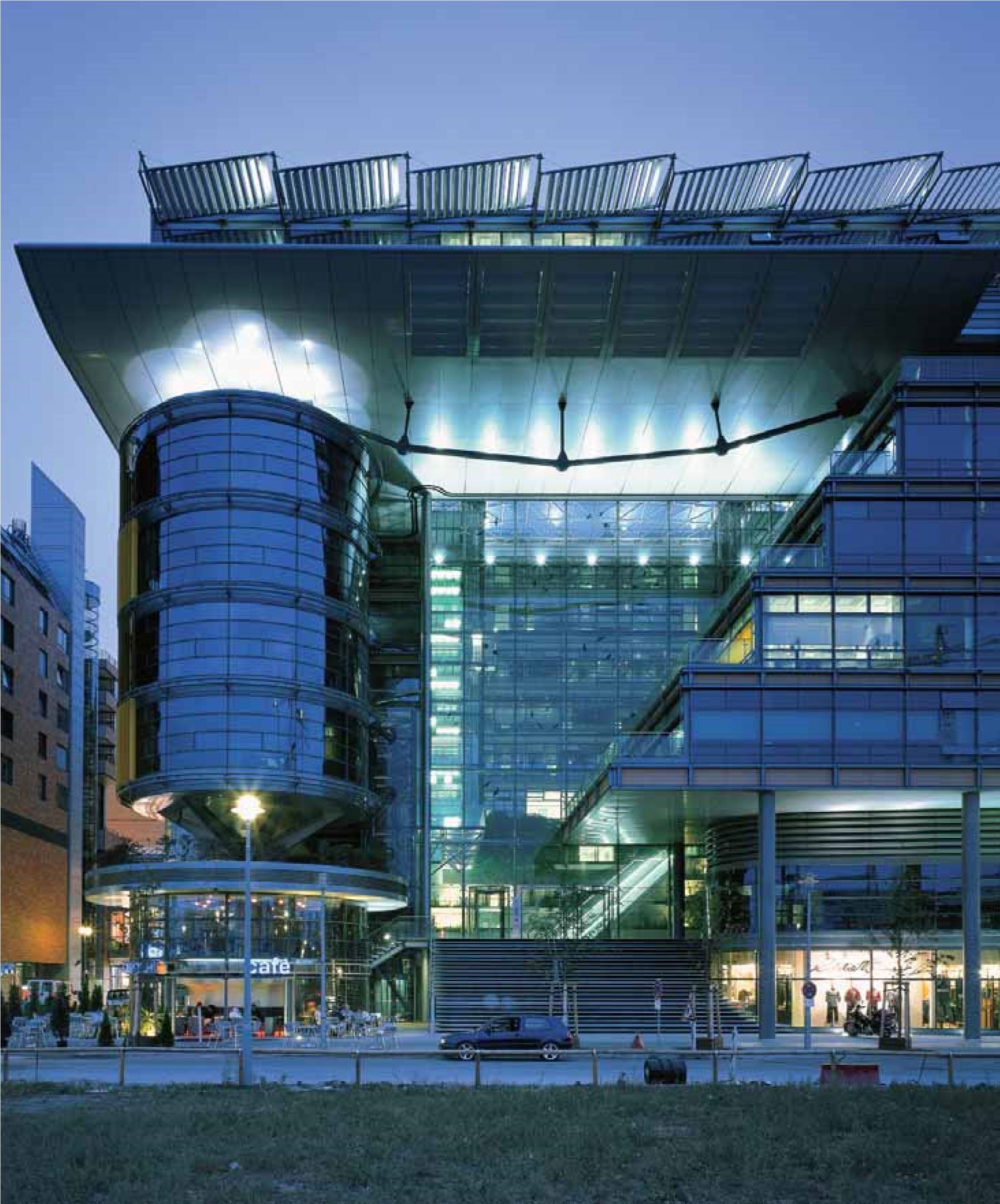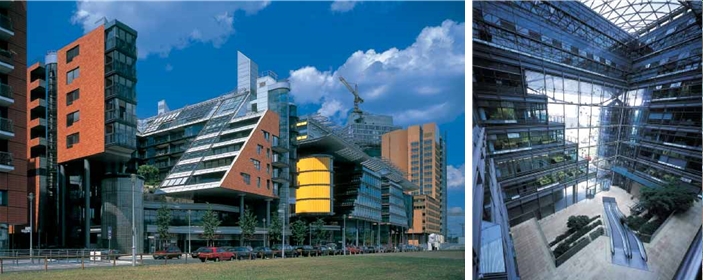Daimler Chrysler office and retail
Integrating low-energy design within a dense urban environment, the buildings are designed to optimise passive solar energy, natural ventilation and daylight.
In 1991 the city authorities opted for a thoroughly conservative masterplan for the redevelopment of the devastated Potsdamer Platz quarter of Berlin (close to the former line of the Berlin Wall), rejecting more radical proposals including those by Richard Rogers Partnership (RRP, now Roger Stirk Harbour + Partners, RSHP). A further competition for the Daimler Chrysler site was won by Renzo Piano and Christoph Kohlbecker. RRP was subsequently commissioned to design three buildings on the site with a total area of 57,800 m².
The brief stipulated that RRP work within the context of the traditional Berlin square block, with buildings no more than nine storeys high formed around potentially oppressive internal courts. To one side, the buildings had to address an enclosed retail arcade raised several storeys above ground level. Working within these constraints, the practice was able to subtly subvert the municipal masterplan to produce buildings of strikingly contemporary appearance which, most significantly, utilised a low-energy servicing agenda.
The key to this strategy was the erosion of the blocks at their south-east corners to allow daylight to penetrate the central courts, which were turned into covered atria to illuminate interiors, and to facilitate views out of the buildings. The atria are naturally ventilated throughout the year, with heating mechanically augmented in winter.
The two office buildings and one residential block were designed for natural ventilation throughout, with intensive research by the RRP team and specialist consultants into the servicing programme partly funded by an European Union grant. As a result, it was estimated that energy consumption in the office buildings would be half that generated by a conventionally air-conditioned building. The facades of the buildings incorporated clear and opaque glass panels, solid areas of ceramic tile cladding, and external and internal blinds, a sophisticated mix which allowed the internal environment to be adjusted in response to the requirements of users. Visually striking, RRP’s contribution to the Potsdamer Platz development challenged conventional wisdom, producing a pioneering low-energy environment for business accommodation.
Project information:
- Place/Date: Berlin, Germany 1993 – 1999
- Client: Daimler Chrysler
- Office Area: 29,000 m² (Building B4 + B6)
- Retail Area: 12,500 m² (Building B4, B6 + B8)
- Architect: Richard Rogers Partnership
- Structural Engineer: Weiske & Partner GmbH/Knebel & Scumacher/ Ove Arup & Partners
- Services Engineer: rp+k sozietät (joint venture with J Roger Preston & Partners)/Schmidt-Reuter und Partner
- Quantity Surveyor: Davis Langdon & Everest/Drees & Sommer AG
- Project Manager: Daimler Chrysler
- Construction Manager: Schmidt-Reuter und Partner
- Office Consultant: Mm Warburg Schlüter & Co
- Landscape Architect: Kruger & Mohler
- Fire Consultant: Debis Risk Consult GmBH/Hosser Hass & Partner
- Façade Engineer: Institut für Fassadentechnik IFFT
- Main Contractor: Müller Altvatter + C Barasel AG GmBH
Awards
--RSHP
Featured articles and news
Latest Build UK Building Safety Regime explainer published
Key elements in one short, now updated document.
UKGBC launch the UK Climate Resilience Roadmap
First guidance of its kind on direct climate impacts for the built environment and how it can adapt.
CLC Health, Safety and Wellbeing Strategy 2025
Launched by the Minister for Industry to look at fatalities on site, improving mental health and other issues.
One of the most impressive Victorian architects. Book review.
Common Assessment Standard now with building safety
New CAS update now includes mandatory building safety questions.
RTPI leader to become new CIOB Chief Executive Officer
Dr Victoria Hills MRTPI, FICE to take over after Caroline Gumble’s departure.
Social and affordable housing, a long term plan for delivery
The “Delivering a Decade of Renewal for Social and Affordable Housing” strategy sets out future path.
A change to adoptive architecture
Effects of global weather warming on architectural detailing, material choice and human interaction.
The proposed publicly owned and backed subsidiary of Homes England, to facilitate new homes.
How big is the problem and what can we do to mitigate the effects?
Overheating guidance and tools for building designers
A number of cool guides to help with the heat.
The UK's Modern Industrial Strategy: A 10 year plan
Previous consultation criticism, current key elements and general support with some persisting reservations.
Building Safety Regulator reforms
New roles, new staff and a new fast track service pave the way for a single construction regulator.
Architectural Technologist CPDs and Communications
CIAT CPD… and how you can do it!
Cooling centres and cool spaces
Managing extreme heat in cities by directing the public to places for heat stress relief and water sources.
Winter gardens: A brief history and warm variations
Extending the season with glass in different forms and terms.
Restoring Great Yarmouth's Winter Gardens
Transforming one of the least sustainable constructions imaginable.


























